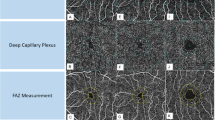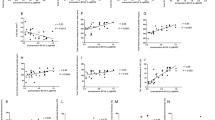Summary
Background: Recent studies have raised confusion about the fluorescein angiographical and histopathological correlation of CNV.
Material and methods: The preoperative fluorescein angiograms of four patients with subfoveal CNV due to ARMD extracted by pars plana vitrectomy were classified as wellor ill-defined CNV and were correlated to the histopathologically (in serial sections) verrified CNV-location (subneuroretinal (= type II according to Gass) versus sub-RPE (type I according to Gass) ).
Results: The locations of all four CNV could be classified by histopathological landmarks as there were RPE, BLD/drusen, and inner Bruchs membrane. Angiographically well-defined membranes were type II membranes according to Gass, whereas the ill-defined membrane represented type I. The CNV with well- and ill-defined borders consisted of type II and type I parts according to Gass.
Conclusion: We find subneuroretinal locations of the well-defined CNV examined (type II membranes according to Gass). Correspondingly, ill-defined CNV or ill-defined parts of a CNV seem to be beneath the RPE (type I). The correlation of fluorescein angiography and histopathology should be studied in greater numbers of well- and ill-defined CNV.
Zusammenfassung
Hintergrund: Aufgrund der bisher publizierten Studien herrscht Unklarheit über die Korrelation fluoreszenzangiographischer und histopathologischer Befunde von chorioidalen Neovaskularisationen (CNV) bei altersbezogener Makuladegeneration (AMD).
Material und Methoden: Die präoperativen Fluoreszenzangiogramme (FLA) von vier exemplarischen Patienten mit subfovealer CNV bei AMD, bei denen via Pars-plana-Vitrektomie eine CNV extrahiert wurde, wurden in gut bzw. schlecht abgrenzbare CNV eingeteilt. Es erfolgte eine Korrelation zur histopathologisch in Serienschnitten festgestellten CNV-Lokalisation (subneuroretinal (= Typ II nach Gass) versus sub-RPE (= Typ I nach Gass) ).
Ergebnisse: Alle vier CNV konnten histologisch anhand der Lagebeziehungen zu RPE, basal laminar deposit/Drusen und innerer Bruchscher Membran klassifiziert werden. Die angiographisch gut abgrenzbaren CNV waren histopathologisch Typ II-Membranen, während die schlecht abgrenzbare CNV den histopathologischen Typ I repräsentierte. Die CNV mit angiographisch sowohl gut als auch schlecht abgrenzbaren Anteilen bestand histopathologisch gleichzeitig aus Typ I- und II-Anteilen.
Schlußfolgerung: Die untersuchten gut abgrenzbaren CNV liegen subneuroretinal (Typ II nach Gass). Dazu passend scheinen schlecht abgrenzbare Membranen bzw. Membrananteile sub-RPE (Typ I nach Gass) lokalisiert zu sein. Die Korrelation von FLA und Histologie bei AMD sollte an einem größeren Kollektiv von gut bzw. schlecht abgrenzbaren CNV überprüft werden.
Similar content being viewed by others
Author information
Authors and Affiliations
Rights and permissions
About this article
Cite this article
Hoops, J., Scheider, A., Messmer, E. et al. Histopathological and fluorescein angiographical correlation of choroidal neovascularization (CNV) associated with ARMD. Ophthalmologe 95, 296–300 (1998). https://doi.org/10.1007/s003470050276
Published:
Issue Date:
DOI: https://doi.org/10.1007/s003470050276




